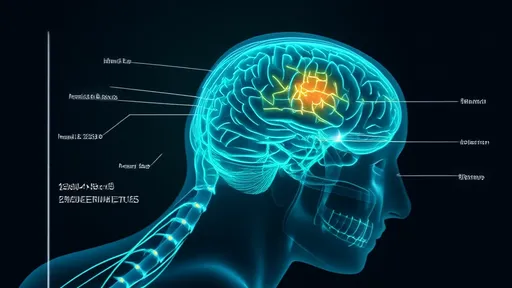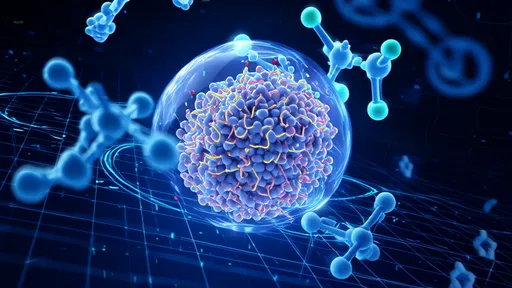The world of ultrafast spectroscopy has entered a revolutionary phase with the advent of attosecond spectral knives—a cutting-edge tool that enables scientists to selectively excite specific vibrational states in molecules. This breakthrough technology is reshaping our understanding of molecular dynamics and opening new frontiers in chemical reaction control. Unlike conventional methods that often excite molecules indiscriminately, attosecond spectral knives offer unprecedented precision by targeting individual quantum states with laser pulses lasting mere billionths of a billionth of a second.
At the heart of this innovation lies the ability to manipulate molecular vibrations with exquisite temporal and spectral resolution. When molecules absorb energy, their constituent atoms begin vibrating in characteristic patterns known as normal modes. These vibrations occur at specific frequencies unique to each molecular structure, much like a fingerprint. Traditional spectroscopy techniques struggle to distinguish between closely spaced vibrational states, but attosecond pulses act as precision scalpels in the frequency domain, cleanly separating and exciting desired states while leaving others untouched.
The development of attosecond spectral knives represents a convergence of several advanced technologies. High-harmonic generation sources produce the necessary ultrashort pulses, while sophisticated pulse-shaping techniques mold these pulses into the required spectral profiles. What makes this approach particularly powerful is its combination of broad bandwidth—covering multiple vibrational transitions simultaneously—and sharp spectral features that can target specific transitions within that bandwidth. This dual characteristic allows researchers to both observe and control molecular dynamics on their natural timescales.
Recent experiments have demonstrated the remarkable selectivity achievable with this method. In studies involving diatomic molecules like nitrogen and oxygen, researchers successfully excited individual vibrational quantum states without perturbing neighboring states just a few wavenumbers away. The implications extend far beyond simple molecules—complex polyatomic systems with dense vibrational spectra are now becoming accessible to state-specific manipulation. This level of control was unimaginable with previous generation femtosecond lasers, which typically excited broad ensembles of states simultaneously.
One particularly exciting application lies in the field of coherent control of chemical reactions. By selectively populating specific vibrational states that lead to desired reaction pathways, scientists can potentially steer chemical transformations with remarkable efficiency. This approach differs fundamentally from traditional thermal activation, where energy distributes statistically among all available modes. The attosecond spectral knife allows researchers to deposit energy precisely where it will be most effective for guiding molecular transformations along chosen coordinates.
The technique's impact extends to fundamental studies of molecular structure and dynamics as well. By examining how selectively excited states evolve over time—through processes like vibrational energy redistribution or coupling to electronic states—researchers gain new insights into the intricate dance of atoms within molecules. These observations provide crucial tests for quantum dynamical theories and computational models, potentially revealing limitations in our current understanding of molecular quantum mechanics.
Implementation challenges remain substantial, particularly when applying the technique to larger molecular systems. As molecular complexity increases, so does the density of vibrational states, making clean state selection more difficult. Researchers are addressing this by developing advanced pulse-shaping algorithms that can account for complex spectral patterns and by combining attosecond pulses with other spectroscopic techniques. The integration with mass spectrometry or electron diffraction methods, for instance, provides complementary information about the structural consequences of selective excitation.
Looking ahead, the attosecond spectral knife promises to transform multiple areas of molecular science. From probing the earliest steps in photochemical reactions to controlling molecular machines at the quantum level, the ability to address specific vibrational states with attosecond precision opens numerous possibilities. As the technology matures and becomes more widely accessible, we can anticipate breakthroughs in fields ranging from fundamental chemical physics to materials design and even quantum information processing, where controlled molecular vibrations may serve as robust quantum bits.
The emergence of this technique also raises intriguing questions about the limits of quantum control in complex systems. How far can we push selective excitation in increasingly large molecules? Can we develop protocols for exciting specific superposition states that exhibit desired dynamical properties? These challenges will drive innovation in both laser technology and theoretical chemistry in the coming years, potentially leading to even more sophisticated tools for manipulating matter at the quantum level.
As with many breakthroughs in science, the attosecond spectral knife's full impact may take years to realize completely. What's certain is that it provides chemists and physicists with a powerful new lens through which to view and influence the molecular world—one vibrational quantum state at a time. The marriage of attosecond time resolution with precise spectral addressing marks a significant milestone in our quest to understand and control matter at its most fundamental level.
The rhythmic lapping of brackish water against tangled mangrove roots conceals one of nature's most extraordinary genetic survival stories. For centuries, these salt-tolerant trees have guarded molecular secrets in their DNA that allow them to thrive where other plants perish. Today, scientists are cracking open this genetic vault through an ambitious international initiative called the Mangrove Gene Bank Project, with groundbreaking implications for global food security.
In the face of accelerating glacial melt due to climate change, scientists and engineers are turning to innovative solutions to slow the disappearance of these critical ice reserves. One such breakthrough is the development of high-albedo fabric covers, colloquially termed "glacial nanoblankets," designed to reflect sunlight and reduce ice ablation. These advanced textiles are emerging as a promising tool in the fight against rising sea levels and ecosystem disruption.
In the race to mitigate climate change, scientists and engineers are turning to the Earth’s own geological processes for solutions. One of the most promising avenues is basalt carbon mineralization, a natural chemical reaction that locks away carbon dioxide in solid rock. This process, often described as nature’s own carbon capture and storage (CCS) system, is now being harnessed and accelerated to combat rising atmospheric CO₂ levels. Unlike traditional carbon storage methods, which rely on fragile seals and uncertain long-term stability, basalt mineralization offers a permanent and geologically secure solution.
The concept of marine cloud brightening through aerosol seeding has emerged as a potential geoengineering strategy to combat global warming. By enhancing the reflectivity of clouds over oceans, scientists aim to increase Earth's albedo, thereby cooling the planet. This approach, while still in experimental stages, has garnered significant attention due to its promise of offsetting some effects of climate change without requiring drastic reductions in greenhouse gas emissions.
For decades, the study of chronic pain has been hampered by the inability to observe neural activity over extended periods. Traditional imaging techniques provide snapshots of brain activity but fail to capture the dynamic, evolving nature of pain processing. A groundbreaking approach using transparent skull implants is now revolutionizing our understanding of how chronic pain manifests and persists in the brain.
In the perpetual darkness of the deep sea, hydrothermal vents spew superheated, mineral-rich fluids into the frigid water, creating oases of extreme chemistry that have fascinated scientists for decades. These underwater geysers, often located along mid-ocean ridges, host complex reactions that may hold clues to the origins of life and the formation of mineral deposits. Until recently, studying these dynamic systems in their natural state posed immense challenges—until the advent of deep-sea chemical robots capable of in situ monitoring.
In a groundbreaking development that merges cutting-edge physics with ancient archaeology, researchers have successfully utilized neutron holography to reveal hidden inscriptions beneath the patina of bronze artifacts. This non-invasive technique promises to revolutionize the study of corroded metal objects, offering unprecedented access to historical texts without damaging delicate surfaces.
The advent of cryo-electron microscopy (cryo-EM) coupled with artificial intelligence (AI) has revolutionized the field of structural biology. By capturing the intricate dance of proteins in their native states, scientists are now able to unravel the dynamic architectures that govern cellular functions. This powerful synergy between cutting-edge imaging and machine learning is not just a technological leap—it’s a paradigm shift in understanding life at the molecular level.
The world of ultrafast spectroscopy has entered a revolutionary phase with the advent of attosecond spectral knives—a cutting-edge tool that enables scientists to selectively excite specific vibrational states in molecules. This breakthrough technology is reshaping our understanding of molecular dynamics and opening new frontiers in chemical reaction control. Unlike conventional methods that often excite molecules indiscriminately, attosecond spectral knives offer unprecedented precision by targeting individual quantum states with laser pulses lasting mere billionths of a billionth of a second.
The global food system is undergoing a quiet revolution, one fermentation tank at a time. In laboratories and production facilities around the world, scientists and entrepreneurs are harnessing the power of microalgae to create what many believe could become the protein source of the future. These microscopic photosynthetic organisms, grown in controlled fermentation environments, are demonstrating remarkable potential to address some of our most pressing nutritional and environmental challenges.
The agricultural sector is undergoing a quiet revolution as artificial intelligence merges with robotics to address one of nature's most vital processes: pollination. In fields across the world, experimental deployments of mechanical pollinator swarms are demonstrating how AI-driven vision systems can collaborate to mimic—and potentially enhance—the work of vanishing bee populations. These autonomous systems represent not just a technological breakthrough, but a necessary adaptation to ecological instability.
For decades, farmers and land reclamation specialists have struggled with the persistent challenge of saline-alkali soils - those unproductive lands where high salt concentrations and alkaline pH levels stunt plant growth and render vast areas agriculturally useless. Traditional remediation methods often proved either too slow, too expensive, or too water-intensive to implement at scale. Now, an innovative electrochemical approach using pulsed electric fields is demonstrating remarkable potential to transform these barren landscapes into fertile ground.
In the rolling hills of Colombia's coffee belt, a quiet revolution is taking place beneath the emerald canopies of coffee plants. Researchers are conducting groundbreaking field trials with genetically edited coffee plants designed to grow beans naturally low in caffeine. This ambitious project could forever change how the world consumes its most popular psychoactive beverage.
For centuries, the intricate world beneath our feet remained largely a mystery. Farmers, ecologists, and biologists could only speculate about the complex interactions between plant roots and soil structure. Traditional methods of studying root systems involved destructive sampling—digging up plants and washing away soil to examine roots. This approach not only killed the plants but also disrupted the very soil architecture researchers sought to understand. However, a quiet revolution in agricultural science is changing everything.
The concept of piezoelectric railways is revolutionizing the way we think about sustainable energy in transportation. By converting the mechanical energy from train-induced vibrations into electrical power, these systems offer a promising solution for reducing dependency on external power sources. The technology leverages piezoelectric materials, which generate electricity when subjected to mechanical stress, embedding them directly into railway tracks. This innovation not only enhances energy efficiency but also aligns with global efforts to combat climate change by minimizing carbon footprints.














